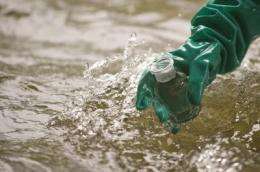Triclosan needs to be monitored

Leipzig. Researchers from Germany and Slovakia have pointed out that the chemical triclosan is one of those particularly harmful substances for the ecological status of rivers that are still not sufficiently monitored. With extensive monitoring conducted in the Elbe river basin that was more comprehensive than standard monitoring procedures, concentrations of the chemical at numerous test sites exceeded the predicted no-effect concentration (PNEC) for algal communities up to a factor of twelve.
From the 500 river basin-specific pollutants investigated, triclosan (normally used as an anti-bacterial agent) ranked sixth as one of the most particularly harmful substances in Europe. It is therefore imperative to include this substance in routine monitoring programmes at the European scale, according to what researchers from the Helmholtz Centre for Environmental Research (UFZ) and the Environmental Institute in Slovakia have written in the journal "Environmental Science Pollution Research".
It is intended that the list of priority substances that have to be monitored by the authorities in Europe will be extended from its current 33 to 45 substances. The chemical triclosan is not one of these new candidates however. This chemical has been on the market since 1972 and it was not until 1998 that the first serious effects were discovered. Until now triclosan has been used as an antibacterial and antifungal agent in personal care products (e.g. toothpaste) and sportswear. Scientists were also very concerned about the fact that nowadays triclosan cannot only be detected in organisms living in wastewater but also in human plasma and in breast milk. Therefore, harmful effects extending beyond water organisms cannot be excluded.
Approximately 350 tons of triclosan were used in the European Union in 2005. However, it is still not monitored in many parts of Europe. " Substances that are not on the list of priority substances do not have to be monitored and substances that are not monitored are usually not included on the list, because too little is known about their environmental relevance", Dr. Peter von der Ohe from the UFZ portrays this dilemma. Within the EU-research project MODELKEY scientists have therefore been closely examining several hundred pollutants in different European river catchment areas and have come up with suggestions on how the monitoring of rivers for chemicals could be improved.
More information: Aquatic Toxicology, 90, 102-108. dx.doi.org/10.1016/j.aquatox.2008.08.003
Provided by Helmholtz Association of German Research Centres



















